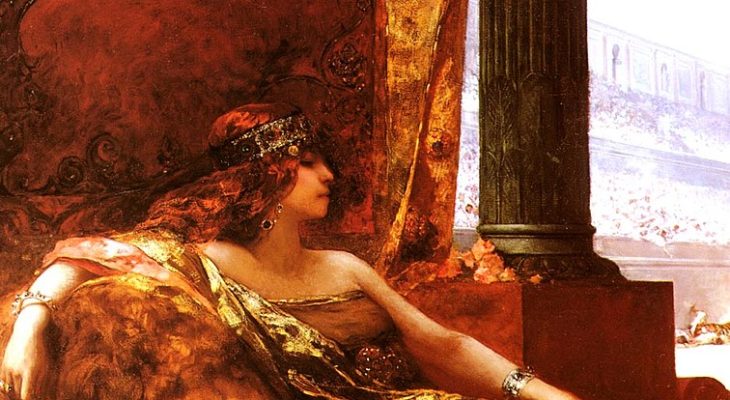If we could have asked Theodora, would she have said whore or empress was the harder job?
Born about 500 A.D., the middle of three daughters to an actress and a bear-trainer in Constantinople, the capital of the Roman Empire, Theodora (meaning, gift of God) did not have an easy childhood.
By some accounts trained as a child acrobat (think gymnast), her father died (mauled by one of his own bears?) when she was young, and there are accounts of a dramatically choreographed appeal, featuring all three girls, in the Hippodrome for her father’s position to be passed to her new stepfather.
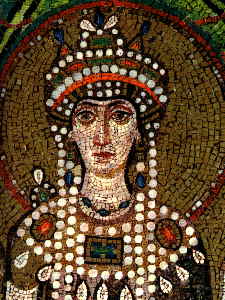
Let’s backtrack. Hippodrome? Constantinople? Rome?
If you’re like me, you were taught only the vaguest notion of 6th century world history. Here’s my quick-and-dirty version:
Roman Emperor Diocletian, decided around 283 A.D. that the Roman Empire had grown too damn big to govern effective from one landlocked Italian city. (Think sending signals to and from the Mars Rover.) He split the empire administratively, with a western capital and an eastern one.
Constantine, the emperor who converted to Christianity, changed the name of Byzantium to Nova Roma, and designated it the main capital of Rome in 330 A.D. The government change stuck (mostly); the name change failed and the city became known as Constantinople.
Rome, the empire, had conquered the “barbarians” of the world, but along with major internal power squabbles, beginning in the fifth century the barbarians started handing Rome-the-city, its ass, repeatedly sacking it. Milan and Ravenna in Italy served as temporary western capitals.
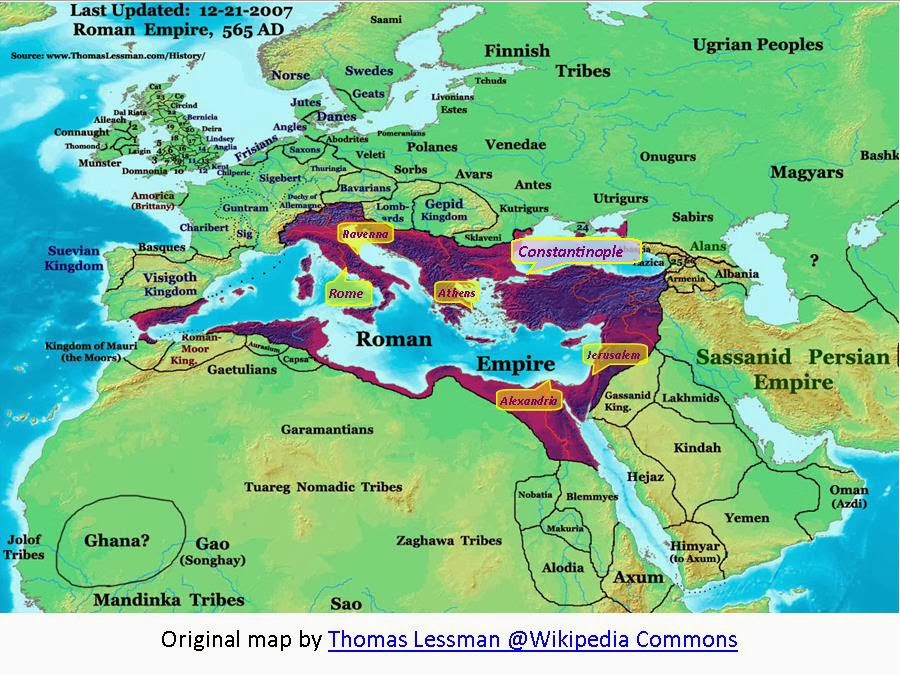
Constantinople, the city, would continue to flourish despite wars, plagues, and religious turmoil. In the 11th century, the Christian religious empire would schism, with the east becoming what we now call Greek Orthodox, and the west becoming Roman Catholic (and each accusing the other of falling away from The True Faith). Constantinople would be the largest European city in the 12th century. Later it would be conquered by adherents of a new religion, Islam, and become one of the chief cities of the Ottoman Empire. Today, as Istanbul, it’s the largest and most well-known city in Turkey, though Ankara is the official capital.
But at the time when Theodora lived, Constantinople = Rome. The people of the city spoke mostly Greek, but as a port city located at the mouth of the Black Sea and on the Mediterranean, they also spoke Aramaic, Syrian, Latin, and more. It was the Byzantine equivalent of New York City; there were the Blues and Greens, the Jets and Sharks of their day, continually beating up on or killing someone of a rival faction.
There were also heated religious disagreements between factions of Christianity over whether the Christ had one nature or two, with Theodora becoming a Monophysite while her husband and the ruling elite were Chalcedonians. Eyes glazed over yet?
Okay, so, the Hippodrome — built for chariot racing and other entertainment (like bear fights), was enlarged and renovated by Constantine; its stands could hold 100,000 spectators (twice as many as the Roman Colosseum).
That would be one mighty long line for the bathroom.
And where you have vast stadiums built to entertain the masses, you need… massive numbers of entertainers.
Leda and the Swan, P0rn Version
While Theodora’s younger sister Anastasia died young, her older sister Comito had talent as a singer. Theodora did not. She had to perform in some manner, but as what? Some reports say she was a child acrobat — think Olympic gymnast. Some reports describe her as a comedic actress (which would fit in well with her sharp intelligence and quick wit).
And then there’s the legend that she devised a provocative routine to recreate the myth of Zeus, who impregnated Leda while wearing the guise of a swan. Theodora cast herself as Leda, and a swan (or geese) were directed to nibble grain from her naked body, including her labia. Legend also has said salacious scenario was a huge hit.
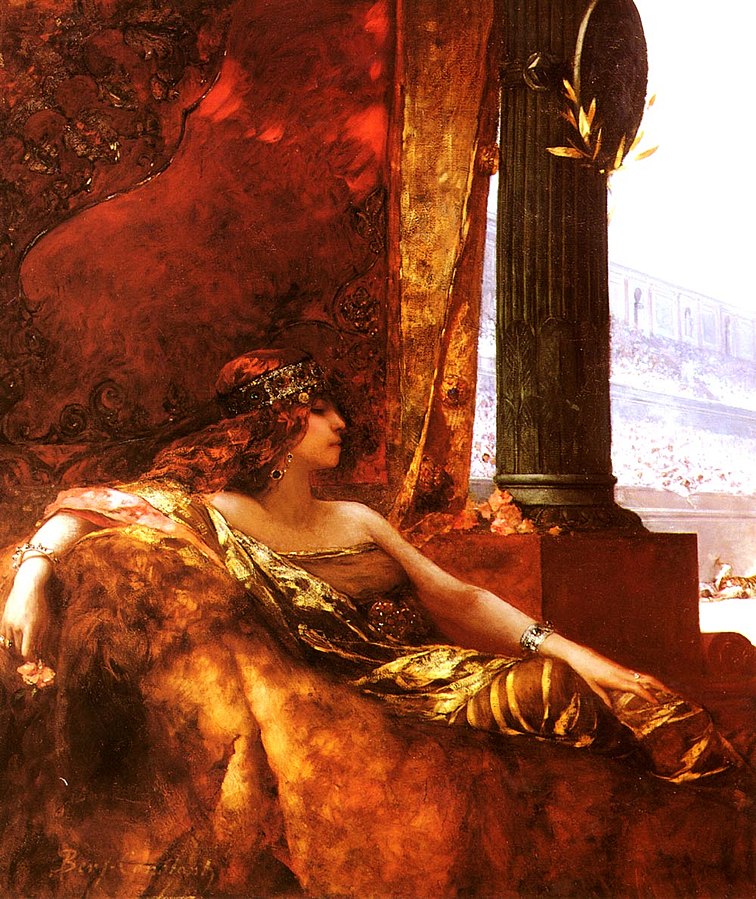
Girlfriends Got Your Back
While intimate details of the relationships are lost, besides her sister Comito/Komito, who may have been a frenemy, Theodora also had Macedonia, a popular dancer, and Antonina, slutty sexually adventurous wife of popular General Belisarius. Was Antonina the connection that led to Theodora meeting Justinian, heir to Emperor Justin, or was it the other way around?
However it happened, Justinian met Theodora, and the rest is history. Literally. He did not cease inveigling his uncle to changes the laws prohibiting their marriage (whores/reformed whores were not allowed to marry patricians), and as soon as possible (1527), they were married. Emperor Justin first made Justinian his co-ruler, and upon Justin’s death, Justinian and Theodora became Emperor and Empress: crowned, anointed, the whole nine yards.
Theodora Did Not Sit Home and Make Baclava — or Babies
Whether it was because she had become infertile, or Justinian was, Theodora did not bear any more children. She did, by all accounts, share equally in all the work of ruling the empire (to the horror of most of the male court observers). Many new pro-women laws were written during their reign. From The Honest Courtesan:
The law which officially de-stigmatized whores was only the first of many increases in women’s rights which Theodora convinced Justinian to enact. In 528, rape law was expanded to cover lower-class women and slaves (who had previously been unprotected) and to mandate the death penalty for either rape or the kidnapping of any woman; this law even defined certain forms of seduction as a lesser (non-capital) form of rape, much like our modern “date rape” laws. In that same year (the first of her reign) Theodora also personally acted to free brothel-whores from bondage by purchasing them at cost from the brothel-keepers, dissolving their contracts, and giving them a new dress and a small amount of money; later she banned such brothels altogether. In 534 it was made illegal to force any woman (even a slave) into acting (and therefore prostitution) without her consent, and in 535 this law was expanded to prohibit underage prostitution even if the girl’s parents consented (which was not uncommon in the poorest families of that time). Another law that year defined marriages as deriving from “mutual affection” and therefore illegalized the practice of new husbands divorcing brides whose parents had reneged on the promised dowry. In 537 a law was enacted to allow actresses or prostitutes to renounce their occupation at will, regardless of previous contracts, and criminalized the practice of forcing women to sign such contracts. Other laws increased the rights of women in divorce, child custody and property ownership and prohibited infanticide and the murder of adulterous wives. And though Theodora died in 548, her views clearly had a lasting influence on Justinian because he continued to enact pro-woman laws even after her death; for example, in 559 he prohibited the imprisonment of women for debt (they were still required to repay) and established a separate women’s prison system (with nuns as guards) in order to prevent the systematic rape and ill-treatment of female prisoners.
During the 532 Nika riots in Constantinople, when everyone else was urging Justinian to flee, Theodora remained resolute and insisted she would stay. That purple (wearing “the purple” was reserved for the Emperor and Empress) made a fine burial shroud. Justinian and Theodora stayed, and did not lose their thrones nor their heads, though much of the city, including the ancient church Hagia Sophia was burned nearly to the ground.
They had it rebuilt, and though two decades later the roof collapsed and had to be rebuilt, it has lasted (with some additional repairs) to the present day.

This was not the first nor last building credited to Justinian, who would later be commonly known as Justinian the Great. In 547 Theodora and Justinian would be immortalized via mosaic portrait on the walls of the San Vitale Basilica in Ravenna, Italy.
There are tales of Theodora ruthlessly eliminating those she considered rivals, either for her power or the affection of her husband. True, or “birther” type rumor or propaganda, it’s impossible to tell from this end of history. Though we know that powerful rulers are rarely nice people all the time.
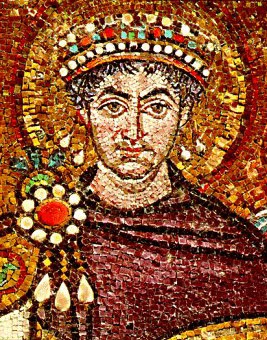
The happy and productive marriage of Justinian and Theodora was almost cut short in 541–542 when the entire Byzantine Empire was struck by the bubonic plague. Constantinople was especially hard hit, with historians estimating as many as five thousand deaths per day at its peak, and 40% of its population dead.
Let that sink in a moment — imagine 40% of the population of New York, Atlanta, or even Dubuque, dead, and the survivors overwhelmed with their own illness, procuring food… and disposing of the bodies.
Justinian himself contracted the disease, and Theodora took charge of the city, the Empire and his nursing. All survived, if somewhat damaged. Many historians cite this plague event as the final piece of the gradual fall of the Roman Empire.
Theodora would establish a convent for women wanting to escape prostitution, called Metanoia (Repentance). (Sources differ as to whether the women were there willingly or were simply rounded up and incarcerated.) She died at age 48 from cancer, possibly breast or uterine cancer. Justinian would outlive her by about twenty years. He is said to have mourned her deeply, and never remarried, living to the age of 83.
Later (I tried but could not find the exact date), the Greek Orthodox Church named both Justinian and Theodora as saints. Their Saints Day is celebrated on 14 November.
In the matching mosaics in the Basilica of San Vitale, completed in Theodora’s lifetime, Justinian is seen carrying the bread for Communion. In Theodora’s panel she is depicted carrying the wine, a not-so-subtle message that both were equal partners in both church and state.
I’d wager that during the days when she was being pimped out by the theatre manager, Theodora never imagined becoming an Empress, let alone a saint and religious icon. What might other smart women accomplish, given the opportunity?
About the Great Sluts in History series:
What makes a woman a “slut,” anyway? From Lilith to Jezebel to Sandra Fluke, it seems that whenever women are in positions of power, open about their sexuality, “too outspoken,” or heaven forbid, all three, they are labeled sluts by some men (and sometimes other women), in an attempt to shame them into “knowing their place.” And into meekly accepting “their place.”This series will look at flawed and wonderful heroines throughout history who insisted on “Following their own weird,” no matter how much it cost them to do so. And how, by doing so, they made the world better for all humans, of all genders, who followed them.
“…it is no longer acceptable to discuss women’s rights as separate from human rights… If there is one message that echoes forth from this conference, let it be that human rights are women’s rights and women’s rights are human rights, once and for all.” ~Hillary Rodham Clinton, 1995
Did you know anything about Theodora, from previous readings? Wouldn’t she have been a fascinating person to know? Your thoughts?
(Originally published on my blog in 2014.)

